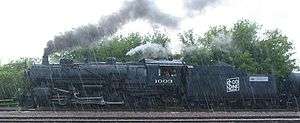Soo Line L-1 class
| Soo Line L-1 class[1] | |||||||||||||||||||||||||||||||||||||||||||||||
|---|---|---|---|---|---|---|---|---|---|---|---|---|---|---|---|---|---|---|---|---|---|---|---|---|---|---|---|---|---|---|---|---|---|---|---|---|---|---|---|---|---|---|---|---|---|---|---|
|
Soo Line 1003, a restored L-1 class 2-8-2 operating in the rain for Wisconsin and Southern Railroad's 25th anniversary celebration in Madison, Wisconsin, 2005-07-23. | |||||||||||||||||||||||||||||||||||||||||||||||
| |||||||||||||||||||||||||||||||||||||||||||||||
| |||||||||||||||||||||||||||||||||||||||||||||||
| |||||||||||||||||||||||||||||||||||||||||||||||
| |||||||||||||||||||||||||||||||||||||||||||||||
The Soo Line L-1 class was a class of 2-8-2 steam locomotive built by the American Locomotive Company in 1913.
Having acquired America's first Mikado (2-8-2) type when it merged the Bismarck, Great Falls and Washburn Railway in 1904,[1] it was eight years before the Soo Line ordered a 2-8-2 of its own. Ten locomotives were ordered from the American Locomotive Company, and built by their Schenectady, New York plant in 1913. The locomotives became the L-1 class and were used for powering time freights system wide on both the Minneapolis, St. Paul and Sault Ste. Marie, and Wisconsin Central. They were assisted in that role by the 1920 arrival of the 25 L-2 and L-20 class Mikados in 1920, but were bumped into lesser roles with the arrival of the 21 N-20 class 4-8-2 Mountains in 1926–1930. The 1938 delivery of four O-20 class 4-8-4 Northern made little difference to the L-1 class since the former were restricted to the Chicago–Twin Cities route.
They were a long-lived class, with only one, the 1004, being retired prior to May 1953.[2] By December 1954 however, the Soo Line was effectively dieselized. One locomotive, the 1003, was placed in the strategic reserve, and stored serviceable in the Gladstone, Michigan roundhouse. The other eight remaining L-1s were sold for scrap.
The reserve was never called into action, and the 1003 was donated to the City of Superior, Wisconsin in December 1959. It was later restored to steam in the 1980s.
References
- 1 2 Gjevre, John A. (1990). Saga of the Soo, West from Shoreham (Second ed.). Moorhead, Minnesota: Gjevre Books.
- ↑ "Soo Line Locomotive Roster, May 1953". Retrieved 2008-06-03.
